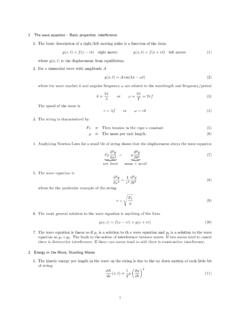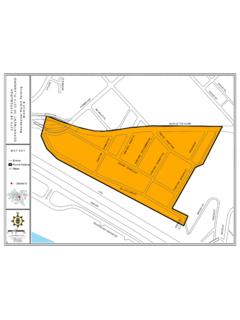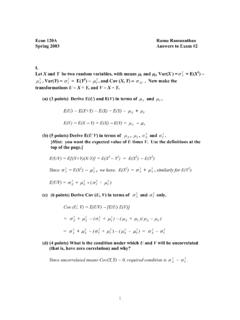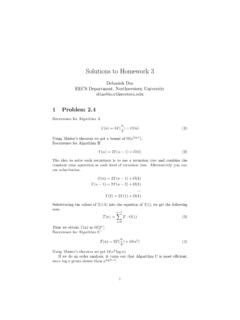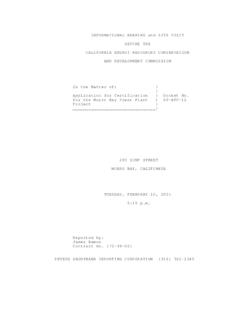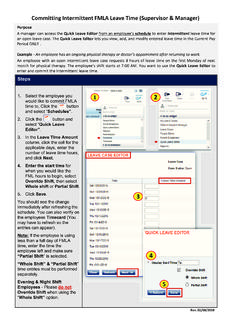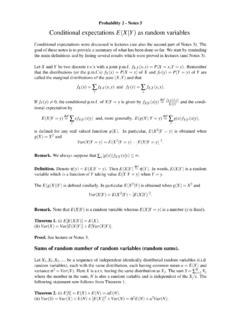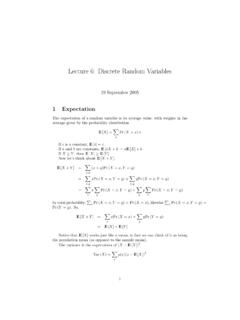Transcription of Gauss Law E - Stony Brook University
1 1 Coulomb lawF=keQ1Q2r2, r(1)ke=14 o= 109Nm2/C2(2) o= 10 12C2/(Nm2)(3)E=Fqo(4)For a point chargeE=keQr2 r(5)For field linesE # of linesArea(6)a=qEm(7) Gauss Law E= E dA(8)=E Afor constant field(9)=EA cos( ) for constant field (10) E= 4 keQnet(11)=Qnet o(12)1. Uniformly Charged 2 o(13)2. Two charged slabsE={ oInbetween the plates0 Outside the plates(14)3. The electric field from a long line of chargeEr=2ke r(15)4. The electric field from a uniformly charged insulat-ing sphere with total chargeQand radiusR,Er={keQr2forr > RkeQR2rRforr < R(16)5.}}
2 The electric field from a uniformly charged con-ducting sphere with total chargeQand radiusR,Er={keQr2forr > R0forr < R(17) V=VB VA= BAE dx(18)For a constant electric fieldEzin thezdirection V= E d(19)= Ezd cos( )(20)= Ezz(21)WyouAB=UB UA=q(VB VA)(22)or U=q V(23)For a point chargeV(r) =keQr(24)Wyou=U=keq1q2r12+keq2q3r23+keq1q3r13(25)Ez= V(z) z(26)Er= V(r) r(27)Ex= V xEy= V yEz= V z(28)V= ke qr= kedqr(29)1. Uniformly charged insulating sphere with chargeQand radiusRV(r) ={keQrforr > RkeQ2R(3 r2/R)forr < R(30)2. Conducting Sphere with chargeQand radiusRV(r) ={keQrforr > RkeQRforr < R(31)3.}}}
3 The potential of a charged disc of radiusaV= 2 ke ( x2+a2 x)(32)24. For a ring of radiusaV=keQ x2+a2(33)CapacitanceC V=Q(34)1. For two plates of areaAand separationdthe ca-pacitance isC= oAd(35)2. For a coaxial cable of lengthLwith inner radiusaand outer radiusbthe Capacitance isC=L2keln(b/a)(36)withke= 1/(4 o)Parallel:Ceq=C1+C2+C3+..(37)Series:1 Ceq=1C1+1C2+1C3+..(38)U=12C( V)2=Q22C(39)UVol=12 oE2(40)E=Eo (41) ind=(1 1 ) o(42)C= Co(43)p 2aq(44) =p E(45)U= p E(46)Currents and CircuitsI=dQdt=Charge passing through surfaceA t(47)V=IR(48)P=I2R(49)J=IA=nqvd(50)J= E(51) =1 (52)R= `A(53)SeriesReq=R1+R2.
4 (54)Resistors in 1 Req=1R1+1R2..(55)Kirchoff Laws1. For each wire indicate a current with an arrow2. The sum of the currents enteringa vertex is in Fig 4. the sum of the vertexI1+ ( I2) + ( I3) = 0(56)where we have written ( I2) and ( I3) becausethese currents are drawn exiting rather than enter-ing the For every closed loop, draw a circle and indicatethe loop direction. The sum of the potential dropsgoing around the loop is zero. V= 0(57)(a) If the current is moving with loop direction(Fig. 5) the voltage drop across the resistor is( V)R= IR(58)If the current and loop direction are oppositeget +IR3(b) If the loop direction is the with the battery(Fig.)
5 3) the voltage change is( V)E= +E(59)If the loop and battery are opposite E(c) For each capacitor if the loop direction is inthe same as the current direction (Fig. 1) thevoltage drop is( V)C= qC(60)whereqis the charge on the capacitor andCisthe capacitance. If current and loop directionare opposite get + Chargingq(t) =Q(1 e tRC)(61)I(t) =ERe tRC(62)with Q=CE. Io=E/R. =RC(63)Capacitor Dischargingq(t) =Qe tRC(64)I(t) = Ioe tRC(65)withIo= and Magnetic FieldsF=qv B(66)r=mvqB(67)dF=IdL B(68)For a uniform magnetic fieldF=ILCD B(69)whereLCDis the line connectingCtoD.
6 A corrlary isthat a closed loop in a uniform magnetic field experiencesno net force (it does experience a torque though).=IA(70) = B(71)U= B= Bcos( )(72)4
